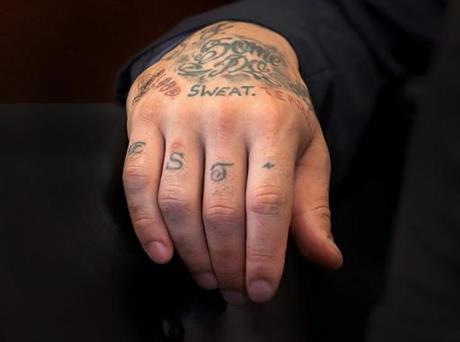
Body art may wind up working against former New England Patriots NFL star Aaron Hernandez who is due in court this week for a pretrial hearing in his upcoming double murder trial.
Hernandez is accused of killing two men he encountered in a Boston nightclub in 2012. His trial is scheduled to begin next month in Suffolk Superior Court.
The former tight end for the New England Patriots is accused of following the men after one of them accidentally bumped into Hernandez and spilled his drink. Prosecutors say he opened fire on their car at a stop light.
Hernandez has pleaded not guilty.
A judge is expected to hear arguments on defense motions during a court hearing scheduled for Thursday.
Hernandez is already serving a life sentence in the 2013 killing of a semi-professional football player Odin Lloyd.
Former NFL star Aaron Hernandez’s tattoos aren’t the first to be used as evidence in a murder trial. Body art has played a role in a surprising number of criminal cases nationwide, though legal experts concede that tattoos by themselves are rarely a deciding factor in convictions.
A Massachusetts judge ruled this week that prosecutors can tell the jury about two tattoos they contend relate to the crimes Hernandez is awaiting trial on: murder charges for the fatal shootings of two Boston men in 2012 and a witness intimidation charge for the nonfatal shooting of a former Hernandez friend in 2013.
Here are some other cases in which tattoos have figured prominently:
MURDER SCENE TATTOO
In 2011, a tattoo helped convict a California gang member in a 2004 fatal shooting at a liquor store. The tattoo on Anthony Garcia’s chest depicted the murder scene, including the name of the liquor store, the Christmas lights outside the store, a light post in the store’s parking lot and a convalescent home located next to the store. The tattoo also showed a chopper spraying bullets on a victim. Garcia’s gang nickname was “Chopper.” A prosecutor called Garcia’s tattoo a “non-verbal confession.”
GANG TATTOOS
Gang members often get tattoos to show allegiance to the group or to boast about a crime they’ve committed for the gang. Just last month, the purported leader of Chicago’s powerful Hobos gang, testifying at his own racketeering conspiracy trial, denied the existence of the gang despite a large tattoo on his arm proclaiming “Hobo: The Earth Is Our Turf.” Gregory “Bowlegs” Chester and five others were convicted last week.
TATTOOS AS IDENTIFYING MARKS
It’s unusual for tattoos to make the difference between a conviction or acquittal, but law enforcement officials frequently use body art to help identify suspects. “What actually comes up in victims’ statements is that they sometimes can recognize a person by a tattoo more than they recognize what their face looks like. It’s something you can latch onto,” said Clairissa Breen, an assistant professor of criminal justice at Buffalo State College.
One problem is that tattoos are usually not specific enough to be seen by juries as proof of a defendant’s guilt. For example, a spider web tattoo can have various criminal meanings, but some may get similar tattoos simply because they like spider webs. “You need a lot more than that to convict someone,” said Boston criminologist Jack Levin.
COVERED TATTOOS
In some cases, judges have granted motions to allow defense attorneys to cover up tattoos they believe will prejudice the jury against their clients. In Florida, a judge decided that the court should pay a makeup artist to cover up a swastika tattoo on the neck of a self-described neo-Nazi accused of stabbing his neighbor and killing a friend of his neighbor’s son. John Allen Ditullio’s lawyers argued successfully that his “scary” tattoos, which also included barbed wire on his face, could influence the jury. Ditullio was convicted of murder and attempted murder. Prosecutors said Ditullio targeted his neighbor because she was friends with a black man and killed her son’s friend because he was gay.
In 2014, a Kansas man charged with murder was given permission to wear a turtleneck to cover a tattoo of the word “murder” spelled backwards on his neck. The same year, an Indiana judge ordered a twice-convicted killer to grow out his hair to cover a new tattoo — “Death Row X 3” — before going on trial for allegedly killing a third person.
AARON HERNANDEZ TATTOOS
What sets the Hernandez case apart is the distinctiveness of two of his tattoos. One depicts a 6-shot revolver with five rounds of ammunition in the cylinder and one empty chamber, with “God forgives” beneath.
Prosecutors say they plan to present evidence that Hernandez fired five shots from a revolver into a car on July 17, 2012, killing two men.
The other tattoo depicts a semi-automatic pistol and a single spent shell casing with a wisp of smoke. Prosecutors accuse Hernandez of shooting his former friend, Alexander Bradley, with a single round from a semi-automatic pistol in 2013 because Bradley witnessed the 2012 double slaying.
Breen said prosecutors could try to persuade the jury that the tattoos are an admission of guilt by Hernandez, but his lawyers would also make a case that they have nothing to do with the crimes. “You can say he was very proficient with a firearm and likes guns and therefore had tattoos of the guns as a means of showing strength or showing an ability to protect himself,” Breen said. “On the other side, you can say five bullets (for the double slaying), and one shell casing with the smoke to show the attack on the other victim. It becomes a matter of whose story speaks better to the jurors.”


